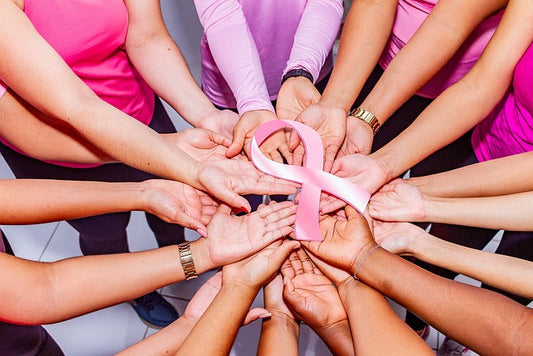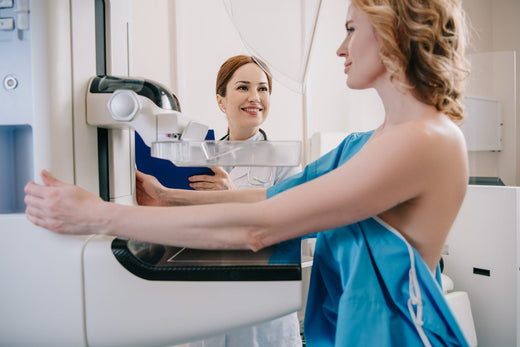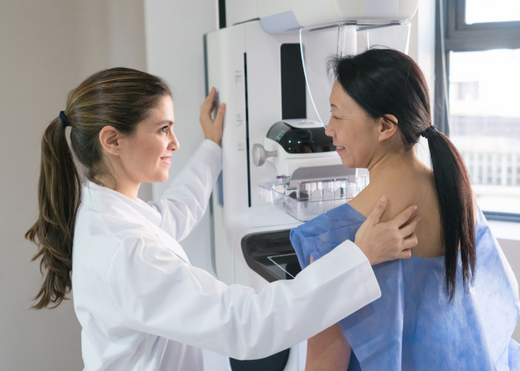How Often Should You Have a Screening Mammogram?
Find out moreWith 1 in 7 women developing breast cancer in their lifetime, breast cancer is one of the most common types of cancer in the UK.
If breast cancer is detected early, there is a very good chance that it can be treated successfully — which is why regular breast cancer screening using a mammogram is so important.
A mammogram is an X-ray of the breasts done by a specialist radiographer called a mammographer. Every woman in the UK will be invited for their first routine mammogram by the NHS between the ages of 50 and 53 years old.
Why do I need a screening mammogram?
Your risk of breast cancer increases with age, so it is important to attend regular screening mammograms once you reach 50 in order to catch any signs of breast cancer in its early, more treatable stages.
Mammograms allow mammographers and doctors to look at the tissue inside the breast and check for changes. From a mammogram, they may be able to see abnormalities such as calcifications, abnormal masses or cysts, and unusual areas of tissue that could be signs of cancer.
Screening mammograms are not suitable for patients with breast symptoms, so if you notice any changes in your breasts, such as a lump, pain, changes in skin appearance or nipple thickening or discharge, then please contact your GP, who will arrange a referral for further investigations that may include a mammogram.
When do you start screening mammograms?
All women in the UK who are registered with a GP will be invited for their first screening mammogram between the ages of 50 and 53. You’ll then be invited to have a mammogram every three years until the age of 71.
Under the age of 50, your risk of breast cancer is low. Mammograms are also not as accurate in younger women, as their breast tissue is denser. For these reasons, routine mammograms are only offered by the NHS to women over 50, unless there is a strong family history of breast cancer. In contrast, annual mammograms are offered to women aged 40-49.
How often should you have a screening mammogram?
You should attend a screening mammogram appointment every three years when you receive your invitation.
You may be wondering why you wouldn’t be invited for a screening every year. This is because X-rays emit a small amount of radiation, so each time you have a mammogram, the body is exposed to a dose. The levels of exposure from a mammogram are well within health guidelines, but having them too frequently isn’t advised unless you have a higher-than-average risk of cancer.
If one of your close family members has had breast cancer, you may be offered genetic testing to see if you are at a higher risk of developing breast cancer. If your risk is increased, you may be offered an annual MRI scan if you’re under 40 or an annual mammogram if you’re over 40.
What to expect when getting a mammogram
Before doing your mammogram, your mammographer will take you through the steps of the screening and answer any questions you have. They’ll then ask you to undress from the waist up and remove any jewellery in preparation for your screening.
Four images are needed for an accurate mammogram — two pictures of each breast from two different angles. When you’re ready, your mammographer will place one of your breasts between two plastic plates. These plates will compress and flatten your breast, and an X-ray will be taken.
After the first X-ray image has been taken, the mammographer will move the machine and reposition your breast for the second angle. They’ll then repeat this process with the other breast.
It’s common to feel discomfort or even some pain during a mammogram. This is due to the pressure required to distribute your breast tissue evenly between the plates. Most women find that any discomfort will cease soon after the mammogram has been done, but tenderness can last for a couple of days for some women.
When do mammograms stop?
You’ll no longer be automatically invited for breast screening when you reach the age of 71.
However, you can still make appointments through your local breast screening service every three years if you want to.
At Check4Cancer, we offer women aged 40 to 49 annual private mammograms and breast screenings to women aged 50+ every two years.
Our rapid access appointments aim to detect breast cancer at an early stage before changes can be felt in the breast and don’t require a GP referral.

Professor Simon Russell
Deputy Chief Medical Officer and Advisor for Breast Cancer
Consultant Oncologist at Addenbrooke’s Hospital, Cambridge and Hinchingbrooke Hospital, Huntingdon, Cambridgeshire. Professor of Oncology, University of Rome Medical School. Professor Simon Russell is a Consultant Oncologist at Addenbrooke’s Hospital, Cambridge and Hinchingbrooke Hospital, Huntingdon. He leads the Urological Malignancy Service and has previously been lead clinician for the breast service. He is the lead for Radiotherapy for Genesis Cancer Care, Cambridge. He has served as the secretary of the British Uro-Oncology Group 2003-2015 and remains a Trustee. He was appointed Professor of Oncology at the University of Rome Medical School, Tor Vergata 2015. Simon joined Check4Cancer in 2018.
Find out moreKnowledge and support
Go to all articles
What is Breast Cancer Awareness Month? All You Need to Know
First introduced in 1985, Breast Cancer Awareness Month runs every October with the initial aim of encouraging breast cancer screening...
Read more
Do Mammograms Hurt?
How a mammogram works, how long it takes, if it’s normal to hurt, and what to expect after a mammogram.
Read more
What Happens At A Mammogram?
Looking at what a mammogram detects, how often you should have a breast screening, and what happens before, during and...
Read more